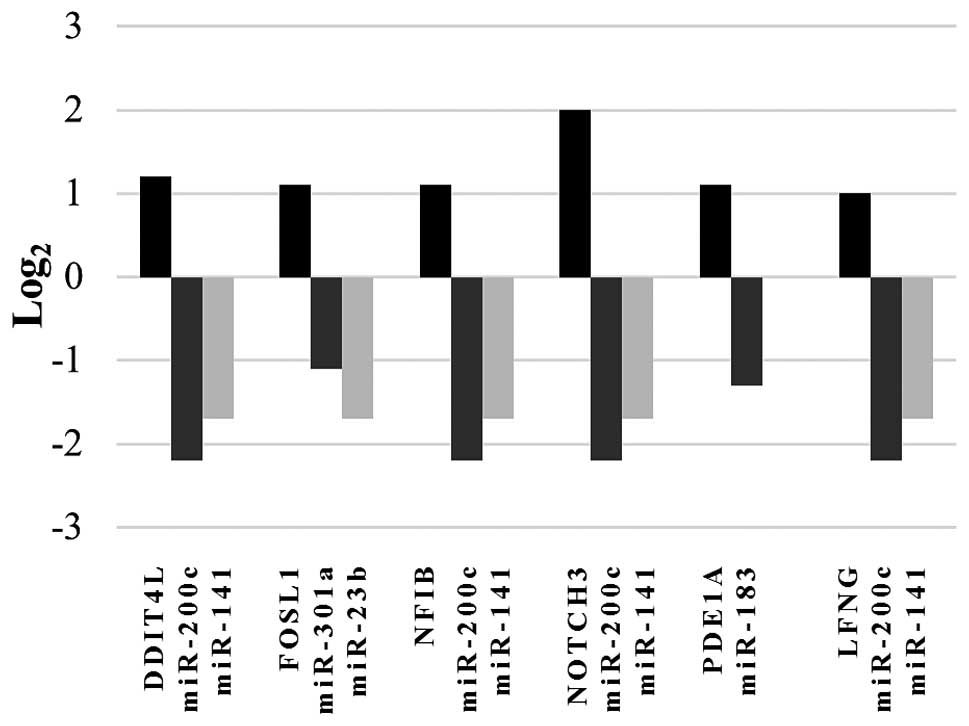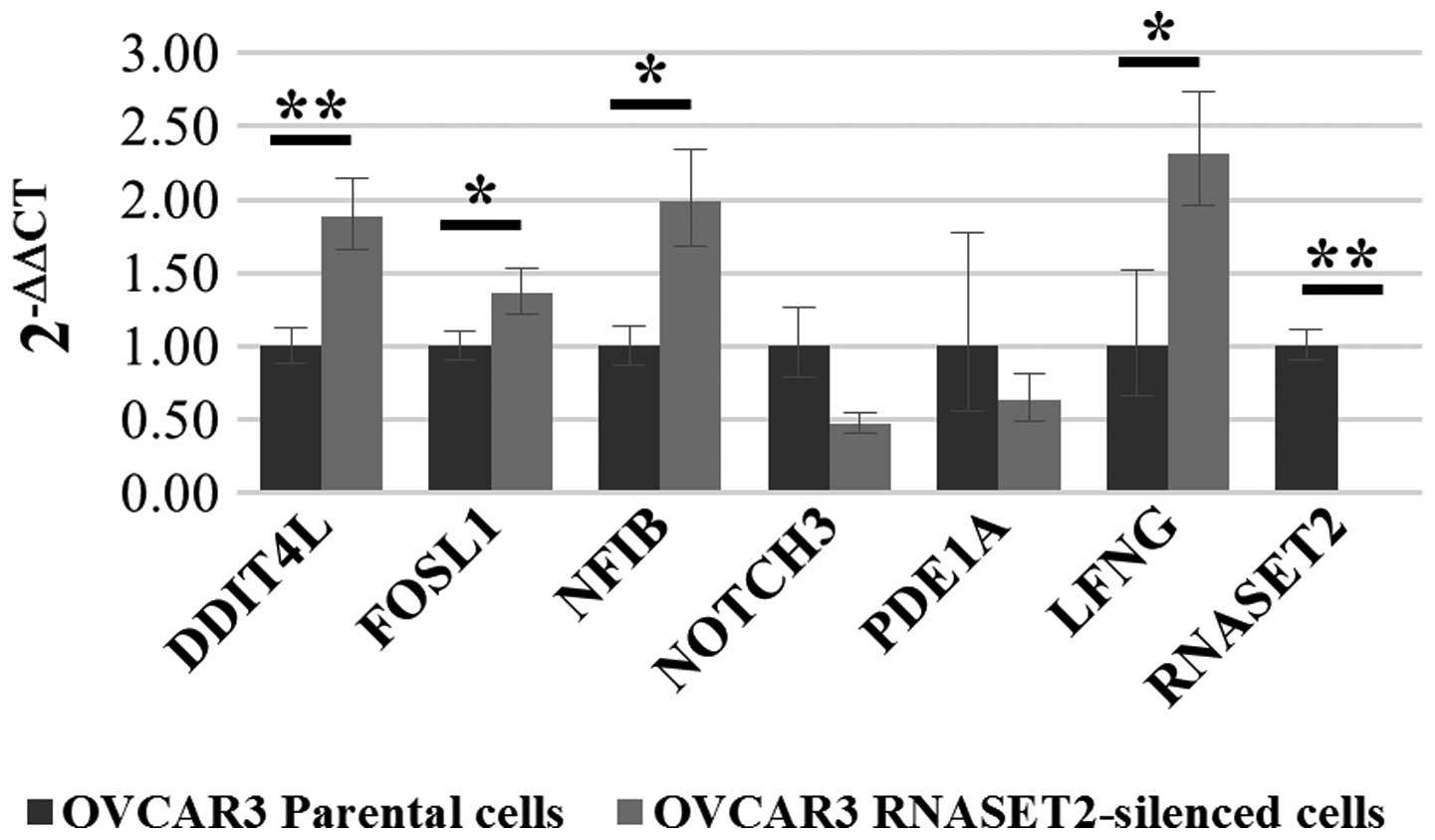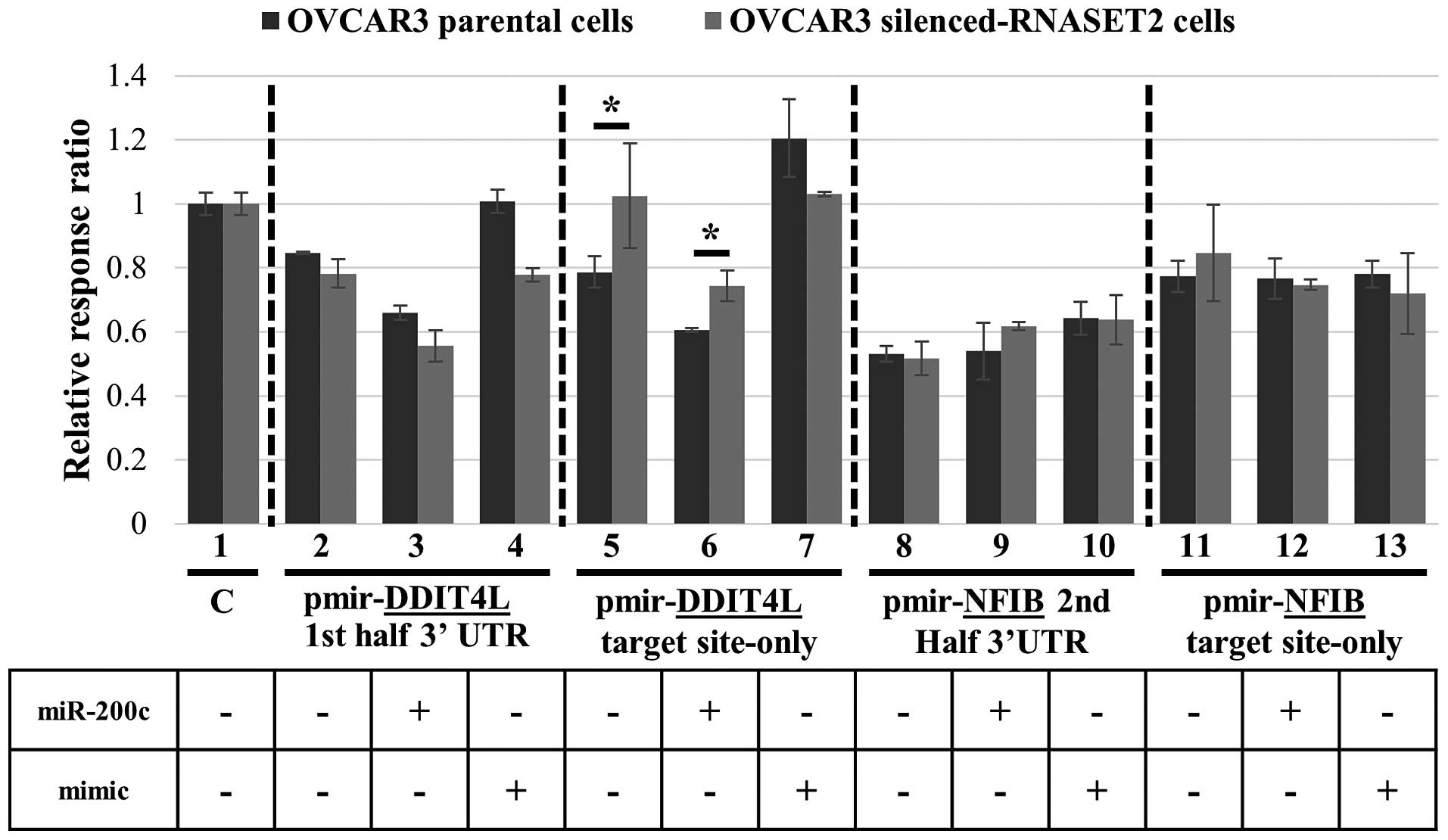|
1
|
Siegel R, Naishadham D and Jemal A: Cancer
statistics, 2012. CA Cancer J Clin. 62:10–29. 2012. View Article : Google Scholar : PubMed/NCBI
|
|
2
|
Sopik V, Iqbal J, Rosen B and Narod SA:
Why have ovarian cancer mortality rates declined? Part I Incidence
Gynecol Oncol. 138:741–749. 2015. View Article : Google Scholar
|
|
3
|
Dahiya N and Morin PJ: MicroRNAs in
ovarian carcinomas. Endocr Relat Cancer. 17:F77–F89. 2010.
View Article : Google Scholar :
|
|
4
|
Li SD, Zhang JR, Wang YQ and Wan XP: The
role of microRNAs in ovarian cancer initiation and progression. J
Cell Mol Med. 14:2240–2249. 2010. View Article : Google Scholar : PubMed/NCBI
|
|
5
|
Katz B, Tropé CG, Reich R and Davidson B:
MicroRNAs in Ovarian Cancer. Hum Pathol. 46:1245–1256. 2015.
View Article : Google Scholar : PubMed/NCBI
|
|
6
|
Bartel DP: MicroRNAs: Genomics,
biogenesis, mechanism, and function. Cell. 116:281–297. 2004.
View Article : Google Scholar : PubMed/NCBI
|
|
7
|
Hwang HW and Mendell JT: MicroRNAs in cell
proliferation, cell death, and tumorigenesis. Br J Cancer.
94:776–780. 2006. View Article : Google Scholar : PubMed/NCBI
|
|
8
|
Esquela-Kerscher A and Slack FJ: Oncomirs
- microRNAs with a role in cancer. Nat Rev Cancer. 6:259–269. 2006.
View Article : Google Scholar : PubMed/NCBI
|
|
9
|
Acquati F, Morelli C, Cinquetti R, Bianchi
MG, Porrini D, Varesco L, Gismondi V, Rocchetti R, Talevi S,
Possati L, et al: Cloning and characterization of a senescence
inducing and class II tumor suppressor gene in ovarian carcinoma at
chromosome region 6q27. Oncogene. 20:980–988. 2001. View Article : Google Scholar : PubMed/NCBI
|
|
10
|
Monti L, Rodolfo M, Lo Russo G, Noonan D,
Acquati F and Taramelli R: RNASET2 as a tumor antagonizing gene in
a melanoma cancer model. Oncol Res. 17:69–74. 2008.PubMed/NCBI
|
|
11
|
Smirnff P, Roiz L, Algelkovitch B,
Schwartz B and Shoseyov O: A recombinant human RNASET2 glycoprotein
with antituorigenic and antiangiogenic characteristics. Cancer.
107:2760–2769. 2006. View Article : Google Scholar
|
|
12
|
Acquati F, Bertilaccio S, Grimaldi A,
Monti L, Cinquetti R, Bonetti P, Lualdi M, Vidalino L, Fabbri M,
Sacco MG, et al: Microenvironmental control of malignancy exerted
by RNASET2, a widely conserved extracellular RNase. Proc Natl Acad
Sci USA. 108:1104–1109. 2011. View Article : Google Scholar :
|
|
13
|
Acquati F, Lualdi M, Bertilaccio S, Monti
L, Turconi G, Fabbri M, Grimaldi A, Anselmo A, Inforzato A,
Collotta A, et al: Loss of function of Ribonuclease T2, an ancient
and phylogenetically conserved RNase, plays a crucial role in
ovarian tumorigenesis. Proc Natl Acad Sci USA. 110:8140–8145. 2013.
View Article : Google Scholar : PubMed/NCBI
|
|
14
|
Lualdi M, Pedrini E, Rea K, Monti L,
Scaldaferri D, Gariboldi M, Camporeale A, Ghia P, Monti E,
Tomassetti A, et al: Pleiotropic modes of action in tumor cells of
RNASET2, an evolutionary highly conserved extracellular RNase.
Oncotarget. 6:7851–7865. 2015. View Article : Google Scholar : PubMed/NCBI
|
|
15
|
Huber W, Carey VJ, Gentleman R, Anders S,
Carlson M, Carvalho BS, Bravo HC, Davis S, Gatto L, Girke T, et al:
Orchestrating high-throughput genomic analysis with bioconductor.
Nat Methods. 12:115–121. 2015. View Article : Google Scholar : PubMed/NCBI
|
|
16
|
Huang W, Sherman BT and Lempicki RA:
Systematic and integrative analysis of large gene lists using DAVID
bioinformatics resources. Nat Protoc. 4:44–57. 2009. View Article : Google Scholar
|
|
17
|
Livak KJ and Schmittgen TD: Analysis of
relative gene expression data using real-time quantitative PCR and
the 2(−Delta Delta C(T)) method. Methods. 25:402–408. 2001.
View Article : Google Scholar
|
|
18
|
Vidalino L, Monti L, Haase A, Moro A,
Acquati F, Taramelli R and Macchi P: Intracellular trafficking of
RNASET2, a novel component of P-bodies. Biol Cell. 104:13–21. 2012.
View Article : Google Scholar
|
|
19
|
Eulalio A, Behm-Ansmant I and Izaurralde
E: P bodies: At the crossroads of post-transcriptional pathways.
Nat Rev Mol Cell Biol. 8:9–22. 2007. View Article : Google Scholar
|
|
20
|
Wang L, Zhu MJ, Ren AM, Wu HF, Han WM, Tan
RY and Tu RQ: A ten-microRNA signature identified from a
genome-wide microRNA expression profiling in human epithelial
ovarian cancer. PLoS One. 9:e964722014. View Article : Google Scholar : PubMed/NCBI
|
|
21
|
Corradetti MN, Inoki K and Guan KL: The
stress-inducted proteins RTP801 and RTP801L are negative regulators
of the mammalian target of rapamycin pathway. J Biol Chem.
280:9769–9772. 2005. View Article : Google Scholar : PubMed/NCBI
|
|
22
|
Luhtala N and Parker R: T2 Family
ribonucleases: Ancient enzymes with diverse roles. Trends Biochem
Sci. 35:253–259. 2010. View Article : Google Scholar : PubMed/NCBI
|
|
23
|
Acquati F, Possati L, Ferrante L,
Campomenosi P, Talevi S, Bardelli S, Margiotta C, Russo A,
Bortoletto E, Rocchetti R, et al: Tumor and metastasis suppression
by the human RNASET2 gene. Int J Oncol. 26:1159–1168.
2005.PubMed/NCBI
|
|
24
|
Kumar S, Nag A and Mandal CC: A
comprehensive review on miR-200c, a promising cancer biomarker with
therapeutic potential. Curr Drug Targets. 16:1381–1403. 2015.
View Article : Google Scholar : PubMed/NCBI
|
|
25
|
Li XY, Li H, Bu J, Xiong L, Guo HB, Liu LH
and Xiao T: Prognostic role of microRNA-200c-141 cluster in various
human solid malignant neoplasms. Dis Markers. 2015:9356262015.
View Article : Google Scholar : PubMed/NCBI
|
|
26
|
Acquati F, Monti L, Lualdi M, Fabbri M,
Sacco MG, Gribaldo L and Taramelli R: Molecular signature induced
by RNASET2, a tumor antagonizing gene, in ovarian cancer cells.
Oncotarget. 2:477–484. 2011. View Article : Google Scholar : PubMed/NCBI
|
|
27
|
Cuaz-Pérolin C, Furman C, Larigauderie G,
Legedz L, Lasselin C, Copin C, Jaye M, Searfoss G, Yu KT, Duverger
N, et al: REDD2 gene is upregulated by modified LDL or hypoxia and
mediates human macrophage cell death. Arterioscler Thromb Vasc
Biol. 24:1830–1835. 2004. View Article : Google Scholar : PubMed/NCBI
|
|
28
|
Haud N, Kara F, Diekmann S, Henneke M,
Willer JR, Hillwig MS, Gregg RG, Macintosh GC, Gärtner J, Alia A,
et al: rnaset2 mutant zebrafish model familial cystic
leukoencephalopathy and reveal a role for RNase T2 in degrading
ribosomal RNA. Proc Natl Acad Sci USA. 108:1099–1103. 2011.
View Article : Google Scholar : PubMed/NCBI
|
|
29
|
Nam EJ, Yoon H, Kim SW, Kim H, Kim YT, Kim
JH, Kim JW and Kim S: MicroRNA expression profiles in serous
ovarian carcinoma. Clin Cancer Res. 14:2690–2695. 2008. View Article : Google Scholar : PubMed/NCBI
|
|
30
|
Chen Y, Zhang L and Hao Q: Candidate
microRNA biomarkers in human epithelial ovarian cancer: Systematic
review profiling studies and experimental validation. Cancer Cell
Int. 13:86–94. 2013. View Article : Google Scholar : PubMed/NCBI
|
|
31
|
Leskelä S, Leandro-García LJ, Mendiola M,
Barriuso J, Inglada-Pérez L, Muñoz I, Martínez-Delgado B, Redondo
A, de Santiago J, Robledo M, et al: The miR-200 family controls
beta-tubulin III expression and is associated with paclitaxel-based
treatment response and progression-free survival in ovarian cancer
patients. Endocr Relat Cancer. 18:85–95. 2010. View Article : Google Scholar : PubMed/NCBI
|
|
32
|
Cochrane DR, Howe EN, Spoelstra NS and
Richer JK: Loss of miR-200c: A marker of aggressiveness and
chemoresistance in female reproductive cancers. J Oncol.
2010:8217172010. View Article : Google Scholar : PubMed/NCBI
|
|
33
|
Chen D, Zhang Y, Wang J, Chen J, Yang C,
Cai K, Wang X, Shi F and Dou J: MicroRNA-200c overexpression
inhibits tumorigenicity and metastasis of
CD117+CD44+ ovarian cancer stem cells by
regulating epithelial-mesenchymal transition. J Ovarian Res.
6:50–60. 2013. View Article : Google Scholar
|
|
34
|
Guo R, Wu Q, Liu F and Wang Y: Description
of the CD133+ subpopulation of the human ovarian cancer
cell line OVCAR3. Oncol Rep. 25:141–146. 2011.
|














